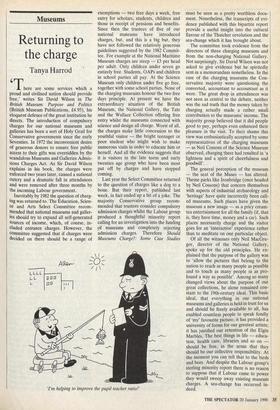Museums
Returning to the charge
Tanya Harrod
There are some services which a proud and civilised nation should provide free,' writes Sir David Wilson in The British Museum: Purpose and Politics (British Museum Publications, £4.95), his eloquent defence of the great institution he directs. The introduction of compulsory charges for our national museums and galleries has been a sort of Holy Grail for Conservative governments since the early Seventies. In 1972 the inconvenient desire of generous donors to ensure free public access to their gifts was overridden by the scandalous Museums and Galleries Admis- sions Charges Act. As Sir David Wilson explains in his book, the charges were enforced two years later, caused a national outcry and a dramatic fall in attendances and were removed after three months by the incoming Labour government.
Inevitably by 1982 the question of charg- ing was returned to. The Education, Scien- ce and Arts Select Committee recom- mended that national museums and galler- ies should try to expand all self-generated sources of income, which, of course, in- cluded entrance charges. However, the committee suggested that if charges were decided on there should be a range of exemptions — two free days a week, free entry for scholars, students, children and those in receipt of pensions and benefits. Since then the trustees of five of our national museums have introduced charges, but, and this is a big but, they have not followed the relatively generous guidelines suggested by the 1982 Commit- tee. For example at the National Maritime Museum charges are steep — £3 per head per adult. Only children under seven go entirely free. Students, OAPs and children in school parties all pay. At the Science Museum only children under five go free, together with some school parties. None of the charging museums honour the two free days principle. At present we have the extraordinary situation of the British Museum, the National Gallery, the Tate and the Wallace Collection offering free entry whilst the museums connected with science and design all charge. Worst of all, the charges make little concession to the youthful visitor — the bright teenager or poor student who might wish to make numerous visits in order to educate him or herself. And all the evidence suggests that it is visitors in the late teens and early twenties age group who have been most put off by charges and have stopped coming.
Last year the Select Committee returned to the question of charges like a dog to a bone. But their report, published last week, in fact ended up a bit of a joke. The majority Conservative group recom- mended that trustees consider compulsory admission charges whilst the Labour group .produced a thoughtful minority report calling for an investigation into the funding of museums and completely rejecting admission charges. Therefore Should Museums Charge?: Some Case Studies 'I'm helping to improve the pupil teacher ratio!' must be seen as a pretty worthless docu- ment. Nonetheless, the transcripts of evi- dence published with this bipartite report provide a useful insight into the cultural flavour of the Thatcher revolution and the sea-change which it has brought about.
The committee took evidence from the directors of three charging museums and from the non-charging National Gallery. Not surprisingly, Sir David Wilson was not asked to give evidence but he spiritedly sent in a memorandum nonetheless. In the case of the charging museums the Con- servative majority were questioning the converted, accountant to accountant as it were. The great drop in attendances was not seen as central to the debate, neither was the sad truth that the money taken by charging actually made a rather small contribution to the museums' income. The majority group believed that it did people good to pay, perhaps even enhanced their pleasure in the visit. To their shame this view was enthusiastically accepted by some representatives of the charging museums — as Neil Cossons of the Science Museum observed, charging there had resulted in 'a lightness and a spirit of cheerfulness and goodwill'.
The general perception of the museum — the seat of the Muses — has altered. Theme parks like Ironbridge (once headed by Neil Cossons) that concern themselves with aspects of industrial archaeology and 'heritage' have quite incorrectly been call- ed museums. Such places have given the museum a new image — as a pricy cream- tea entertainment for all the family (if, that is, they have time, money and a car). Such places necessarily charge and the visitor goes for an 'interactive' experience rather than to meditate on one particular object.
Of all the witnesses only Neil MacGre- gor, director of the National Gallery, spoke up for the old principles. He ex- plained that the purpose of the gallery was to 'allow the pictures that belong to the nation to reach as many people as possible and to touch as many people in as pro- found a way as possible'. Among so many changed views about the purpose of our great collections, he alone remained con- stant to the 19th-century ideal. This basic ideal, that everything in our national museums and galleries is held in trust for us and should be freely available to all, has enabled countless people to speak fondly of 'my' favourite picture; it has provided a university of forms for our greatest artists; it has justified our retention of the Elgin Marbles. The best things in life — educa- tion, health care, libraries and so on should be free, in the sense that they should be our collective responsibility. At the moment you can tell that to the birds and bees. And despite the Labour group's sterling minority report there is no reason to suppose that if Labour came to power they would sweep away existing museum charges. A sea-change has occurred in- deed.


















































 Previous page
Previous page